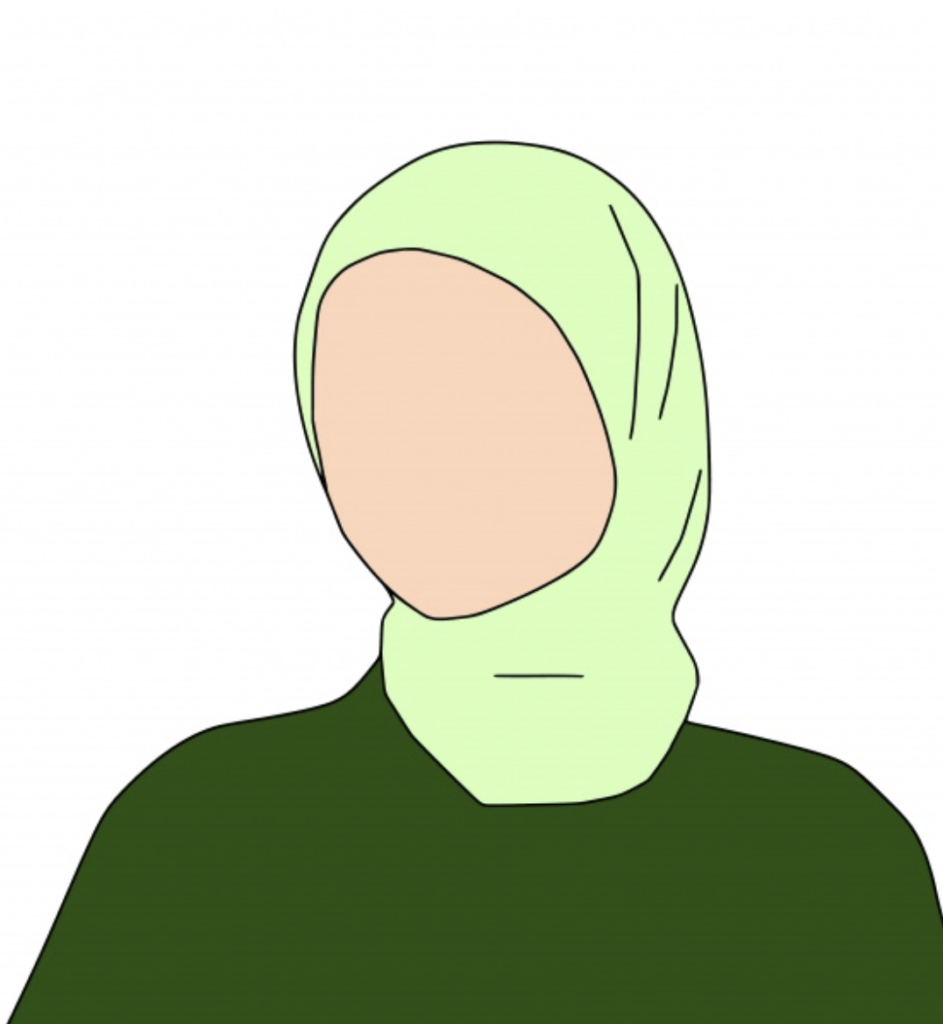To Wear or Not To Wear The Hijab

By: Saba Jobah / Contributing Writer
Modern Feminism turned Aggressor
Often muslim women wearing the hijab will find themselves as the victim of modern feminism. How could that be? Instead, it has become extremely one-sided in supporting sexual liberation and used in anti-feminist narratives. As stated by Haq, “… on October 4, 2021, a seven-year-old girl had her hijab ripped from her head by her teacher in New Jersey who told her ‘that her hair was beautiful and she did not have to wear hijab to school anymore.'” A sentiment that is widely held across modern feminism is that a woman who is covered is not freed of oppression.
It is ironic to not allow a woman who is confidently wearing her beliefs to simply exist as she is. As if it is not bizarre enough, there is also aggression to accompany the ideological disagreement. The New Jersey attack is one of the many instances of modernized feminists attempting to take over the narrative of feminism. Modernized feminists have a superior complex over women who wear a hijab. Besides forced or pressured removal of the hijab, there is also fear of it.
Islamophobia Unleashed onto Women Who Wear the Hijab
Haq details the ordeal of a French researcher wearing a hijab to pick up her son. “One of the mothers told her to put on a hat and to stop ‘making a scene’ and ‘traumatizing the students.'” (Haq). As seen in this situation, the woman wearing the hijab is seen as a visual symbol of Islam. Islam in the West causes disarray because most Western countries had the goal of conquering the East. In addition, eradicating Eastern identity was a necessary step to then successfully control the people and their land. This is where colonialism plays a role in the superior complex within modern feminism against woman wearing the hijab.
Colonialism
The main issue between the West and East stems from the colonial contact with the Muslim Identity. For example, “Amin’s book in fact essentially reproduced colonial narrative of the day as to the inferior Muslim Other, an inferiority and otherness symbolically connoted in European discourse by the veil.” (Ahmed). Furthermore, the strategy at hand is to attack Muslims with the focal point of many societies, women. When the West views the women of Islam they are unable of seeing them as individuals as they see the fabric across their bodies. With this observation, the colonizers carry on with their attack claiming the Muslims are inferior in the way they veil the women.
But so what? What does the white man have to do with a brown woman’s feminist agenda? To give an instance, “This narrative itself was a variant of the colonial trope designating other cultures, and in particular the practices of other cultures in relation to women, as inferior… the colonial trope that Gayatri Spivak famously called the trope of ‘white men saving brown women from brown men.'” (Ahmed). In attacking the treatment of women in cultures deemed as inferior, the white man has found an access pint to swoop in and fix the issue. In reality, the white man’s goal is to break down the structure of these societies and build their own through their cultural influence.
Control Over Oriental Bodies
There is an immense effort to control the relationship between the West and the East, specifically the Islamic East as inferior and superior.”Destroying the covering of the Muslim woman was a critical part of the imperialist and colonial battle in Algeria and remains a method of domination today.” (Haq). Domination is the key term within colonialism, domination over Muslim women’s bodies was needed for the West to conquer the East.

Moreover, there was great interest in what Eastern Muslim women looked like. One can see that in the painting, “Women of Algiers in their Apartments” (1834) by Eugene Delcroix. This painting depicts three Algerian women in their leisure time at home with a slave. Their bodies are exposed as they casually smoke the hookah. Delcroix demonstrates the desperation of the West to break through the walls of cloth and even homes to view women in a state that they view as exotic and sensual. However, whilst Western men have proven to not respect a women’s right to autonomy Eastern men don’t have a great track record either.
Legitimately Forced to Wear the Hijab
Unfortunately, Muslim women’s bodies are not only under attack by colonial feminism but also violent anti-feminism and misogyny driven by misinterpreted Islamic views. A infamous case is Mahsa Amini from Iran. Shortly after her arrest due to improper hijab she, “… fell into a coma shortly after collapsing at a detention centre, and died three days later, officially of a heart attack.” (UN News). The young women was seen wearing her hijab but it was not up to standards. This is a blatant abuse of power and it demonstrates the lack of empathy for Muslim women by their own fellow Muslims.
In the case of Hafsa, it was her own brother enforcing the hijab upon her through violence. As illustrated, “One day after that, she posted another video of herself in hijab, with her face still bruised, reportedly explaining that her brother beat her for not wearing her head covering in the original video.” (Floria). Once again a woman is attacked for not wearing the hijab, but this time it’s her brother. Muslim women deserve better, they deserve societies in which they are positively supported in their Islamic journey. Islam encourages patience and respect to be practiced, these women were not respected or provided with proper guidance to make their own decision on the hijab. However, this does not mean that Islam as a whole is to be seen as the cause of abuse. Rather ignorance and hatred against women in general whether the wear or don’t wear the hijab.

Forever and Always a Pair
What Muslim women need is support and love from communities that guide them closer to their faith. Musawah is one the many organizations that provide the judgement free support to Muslim women who choose to wear or not wear the hijab. As stated in their article in regards to the abuse of the Mortality Police in Iran, “We hold firmly to the Qur’anic principle of ‘no compulsion in religion’ (2:256).” (Musawah).
Muslim Women For’s mission states, “These three women recognized that Muslim women and women of color like themselves often experience spaces (both Muslim and non-Muslim) that are dominantly led by cis men…” (Muslim Women For). This organization beautifully takes into consideration the multiple sides of misogyny Muslim women face. Furthermore, “Today, Muslim Women For is a grassroots organization of diverse women leaders whose mission is to embody and be an effective voice of the Qur’anic ideals of human dignity…” (Muslim Women For). Muslim Women For solidifies that women can stand up to misogyny and discrimination from their own Muslim communities whilst carrying the values and teachings of Islam close to heart.
All in all these organizations display the relationship Muslim women have with their hijab and feminism. The hijab and feminism will forever and always be a pair for Muslim women who wear the hijab.
Works Cited
“Alarm over Iranian Woman’s Death after ‘improper’ Hijab Arrest | UN News.” United Nations, United Nations, news.un.org/en/story/2022/09/1127131. Accessed 17 Sept. 2023.
Attrino, Anthony G. “N.J. Olympian Says Elementary School Teacher Pulled Hijab from 7-Year-Old Girl’s Head.” Nj, 8 Oct. 2021, www.nj.com/education/2021/10/nj-olympian-says-elementary-school-teacher-pulled-hijab-from-7-year-old-girls-head.html.
Delcroix, Eugene. “Women of Algiers in Their Apartments” . 1834.
Florio, Gina. “Somali Woman Brutally Beaten by Brother for Dancing on TikTok without Hijab, and the Feminist Activists Are Silent.” Evie Magazine, https://images.ctfassets.net/ydv6sq0kb5bw/VPXcVUzPNoYjdNmMuwo8m/a2be598830e9b26d963308c6e3cab05b/evie-logo.png, 17 July 2023, www.eviemagazine.com/post/somali-woman-brutally-beaten-brother-dancing-tiktok-hijab-feminist-activsts-silent.
François, Myriam. “‘I Felt Violated by the Demand to Undress’: Three Muslim Women on France’s Hostility to the Hijab.” The Guardian, Guardian News and Media, 27 July 2021, www.theguardian.com/world/2021/jul/27/i-felt-violated-by-the-demand-to-undress-three-muslim-women-on-frances-hostility-to-the-hijab.
Haq, Maheen. “The War on Muslim Women’s Bodies: A Critique of Western Feminism.” Georgetown Law, 17 Jan. 2022, www.law.georgetown.edu/immigration-law-journal/blog/the-war-on-muslim-womens-bodies-a-critique-of-western-feminism/.
McCann, Carole R., et al. “The Veil Debate—Again.” Feminist Theory Reader: Local and Global Perspectives, Routledge, Taylor & Franics Group, 2017, p. 9.
Morris, Rosalind C., and Gayatri Chakravorty Spivak. Can the Subaltern Speak?: Reflections on the History of an Idea. Columbia University Press, 2010.
“Musawah Statement of Solidarity with the Women of Iran.” Musawah, 29 Sept. 2022, www.musawah.org/press/musawah-statement-of-solidarity-with-the-women-of-iran/.“Who We Are.” Muslim Women For, 16 June 2023, muslimwomenfor.org/who/.
Check out Arab America’s blog here!









